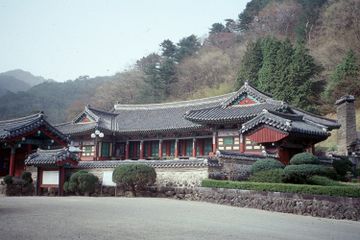"합천 해인사 홍제암"의 두 판 사이의 차이
(→영문) |
(→영문) |
||
| 30번째 줄: | 30번째 줄: | ||
'''Hongjeam Hermitage of Haeinsa Temple, Hapcheon''' | '''Hongjeam Hermitage of Haeinsa Temple, Hapcheon''' | ||
| − | This is an auxiliary | + | This hermitage is an auxiliary hermitage of Haeinsa Temple and is located to the west of the temple. |
| − | It was | + | It was first established in 1608 by Yujeong (1544-1610), also known as Master Samyeong, who led monk soldiers during the Japanese invasions of 1592-1598. He practiced the teachings of the Buddha here until his death. The name of the hermitage comes from the name given to Yujeong after his death by King Gwanghaegun (r. 1608-1623) in a gesture of mourning. |
| − | The worship hall enshrines a | + | The worship hall enshrines a statue triad, with Amitabha (the Buddha of the Western Paradise) in the center flanked by two attendant buddhas, Avalokitesvara (Bodhisattva of Great Compassion) and Mahasthamaprapta (Bodhisattva of Wisdom and Strength). To the right of the worship hall is Yeongjajeon Hall, built in 1614, where portraits of 16 monks, including that of Yujeong, are enshrined. It was dismantled and renovated in 1979. |
| − | + | The stupa and stele of Yujeong (Treasure No. 1301) is located to the right of the hermitage. | |
| + | |||
| + | |||
| + | * 구조 설명은 잘못되어 있는 것 같다. 의논을 하고 수정할게요~ | ||
| + | ** 문화재청 참조... | ||
===영문 해설 내용=== | ===영문 해설 내용=== | ||
2020년 4월 16일 (목) 13:17 판
| 합천 해인사 홍제암 Hongjeam Hermitage of Haeinsa Temple, Hapcheon |
|
 합천 해인사 홍제암, 국가문화유산포털, 문화재청. |
|
| 대표명칭 | 합천 해인사 홍제암 |
|---|---|
| 영문명칭 | Hongjeam Hermitage of Haeinsa Temple, Hapcheon |
| 한자 | 陜川 海印寺 弘濟庵 |
| 주소 | 경남 합천군 가야면 치인리 21 |
| 국가유산 종목 | 보물 제1300호 |
| 지정(등록)일 | 2000년 9월 28일 |
| 분류 | 유적건조물/종교신앙/불교/사찰 |
| 시대 | 조선시대 |
| 수량/면적 | 1동 |
| 웹사이트 | 합천 해인사 홍제암, 국가문화유산포털, 문화재청. |
|
|
|
해설문
국문
홍제암은 임진왜란 때 승병을 일으켜 나라를 지킨 사명대사가 선조(재위 1567-1608)의 하사로 1608년에 창건하여 수도하시다가 입적하신 곳이다. 1614년(광해 6년)에 혜구(慧球)스님이 영자전(影子殿)을 지어 서산ㆍ사명ㆍ영규대사의 영정을 봉안하였고, 1674년에 현종이 홍제당(암)을 사액(賜額)하였으며 그동안 6차례 보수하였다. 현존 건물은 박정희 대통령의 특별예산 조치로 1979년 10월에 완전 해체 복원하였다.
경내에는 대사의 일대기를 기록한 사명대사탑 및 석장비(보물 제1301호)가 있다.
영문
Hongjeam Hermitage of Haeinsa Temple, Hapcheon
This hermitage is an auxiliary hermitage of Haeinsa Temple and is located to the west of the temple.
It was first established in 1608 by Yujeong (1544-1610), also known as Master Samyeong, who led monk soldiers during the Japanese invasions of 1592-1598. He practiced the teachings of the Buddha here until his death. The name of the hermitage comes from the name given to Yujeong after his death by King Gwanghaegun (r. 1608-1623) in a gesture of mourning.
The worship hall enshrines a statue triad, with Amitabha (the Buddha of the Western Paradise) in the center flanked by two attendant buddhas, Avalokitesvara (Bodhisattva of Great Compassion) and Mahasthamaprapta (Bodhisattva of Wisdom and Strength). To the right of the worship hall is Yeongjajeon Hall, built in 1614, where portraits of 16 monks, including that of Yujeong, are enshrined. It was dismantled and renovated in 1979.
The stupa and stele of Yujeong (Treasure No. 1301) is located to the right of the hermitage.
- 구조 설명은 잘못되어 있는 것 같다. 의논을 하고 수정할게요~
- 문화재청 참조...
영문 해설 내용
홍제암은 해인사 서쪽에 위치한 부속암자이다.
임진왜란 때 승병장으로 활약했던 사명대사 유정(1544-1610)이 1608년 이곳에 초가 암자를 짓고 수도하다가 입적하였다. 암자의 이름은 광해군(재위 1608-1623)이 사명대사의 입적을 애도하며 내린 시호를 따서 지었다.
불전에는 본존인 아미타불과 협시불인 관음보살과 대세지보살이 모셔져 있으며, 불전 오른쪽에는 1614년에 지은 영자전이 있다. 영자전에는 사명대사를 비롯한 고승 16명의 영정을 모셨다. 지금의 건물은 1979년 해체 보수한 것이다.
홍제암 오른쪽에는 사명대사의 부도와 석장비(보물 제 1301호)가 있다.
참고 자료
- 문화콘텐츠닷컴 http://www.culturecontent.com/content/contentView.do?content_id=cp052801780001 - 사명대사 일대기 정리
- 전통사찰총서 20 - 경남의 전통사찰 3, 사찰문화연구원, 2005.
- 문화재청 국가문화유산포털 http://www.heritage.go.kr/heri/cul/culSelectDetail.do?VdkVgwKey=12,13000000,38&pageNo=1_1_1_0
- 오마이뉴스 2008.3.19. 기사 http://www.ohmynews.com/NWS_Web/View/at_pg.aspx?CNTN_CD=A0000859082
- 해인사 홍제암 실측조사보고서, 문화재청, 2004.
- 홍제암 ->‘인법당(큰 법당이 없는 절에서 중이 거처하는 방에 불상을 모신 집)’ 용어 사용해서 설명할 것인지..? 1770년(영조 46) 해봉이 중건했다고 하며 그 이후에도 수차례 보수한 것이라고 한다. 현 건물은 1979년 10월에 완전 해체 복원한 것이다.
- 다른 구조 추가 설명? -> 왼쪽 : 서래당 / 서래당 뒤편 : 근현대 한국불교 대표 승려 자운 (1911~1992) 영각 / 뒤편에 별도 건물 (정견각) - 산신각 역할 하는 것으로 추정
- 사명대사 주요 행적 -> 16세에 출가, 임진왜란 당시 평양성 탈환에 공을 세움 , 1604년 국서를 가지고 왜로 건너가 강화를 체결하고 조선인 포로 3천여 명을 데리고 돌아옴. 1608년 홍제암 자리에 초가 암자를 짓고 수도하다가 1610년 입적.
- 현판의 ‘표충사’는 조선 영조 때 불렸던 명칭. 밀양에도 사명대사의 영정을 모신 표충사가 있기 때문에 후에 홍제암에서는 ‘표충사’라는 이름을 쓰지 않게 되었음.
- 홍제암 일원에 있는 부도(뒷쪽 산 입구 위치)는 입적한 해인 1610년에, 비석(오른쪽 담장 밖 위치)은 1612년에 세워진 것이다.